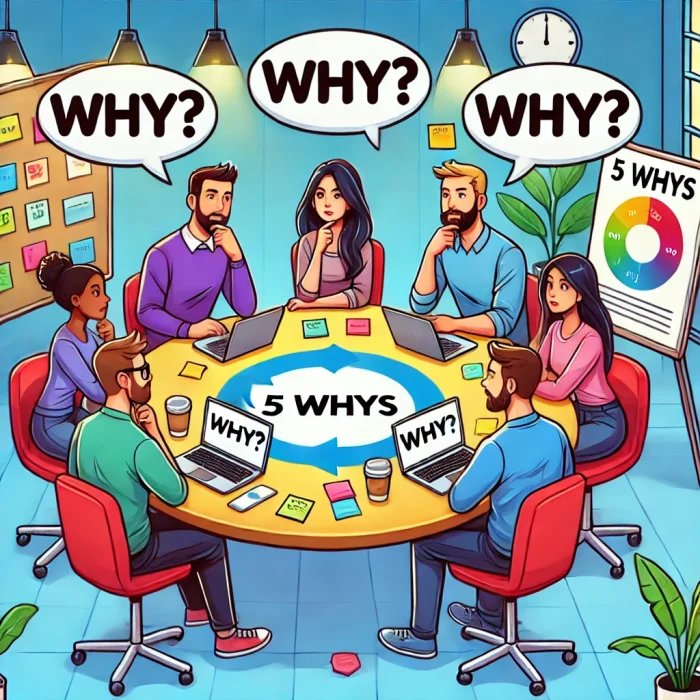Root cause analysis is critical for solving complex problems in Agile, and the 5 Whys technique is one of the simplest yet most effective tools to uncover underlying issues. By repeatedly asking “Why?” your team can dig beneath the surface of a problem to identify its root cause and implement lasting solutions. This article explores the 5 Whys technique, its benefits, and how it can be applied effectively in Agile workflows.
What Is the 5 Whys Technique?
The 5 Whys technique is a problem-solving method used to identify the root cause of an issue by asking “Why?” five times (or as many times as necessary). Each “Why?” builds on the answer to the previous question, peeling back layers of symptoms to reveal the core problem.
This approach is particularly effective in Agile environments, where continuous improvement and iterative processes are key to success. By identifying and addressing root causes, teams can minimize recurring issues and enhance overall productivity.
How to Perform a 5 Whys Analysis
Step 1: Identify the Problem
Start by clearly defining the issue. Ensure everyone on the team understands what the problem is and how it impacts the workflow or deliverables.
Example: The team failed to deliver a feature by the end of the sprint.
Step 2: Ask “Why?” for the First Time
Ask why the problem occurred. Document the answer as it will serve as the foundation for subsequent questions.
Why?: The feature wasn’t ready for deployment.
Answer: Development took longer than expected.
Step 3: Continue Asking “Why?”
Keep asking “Why?” based on the previous answer. Dive deeper with each question until you reach the root cause.
Why?: Development took longer because the requirements weren’t clear.
Why?: The requirements weren’t clear because the Product Owner didn’t have enough information.
Why?: The Product Owner didn’t have enough information because stakeholder feedback was delayed.
Why?: Stakeholder feedback was delayed due to unclear communication channels.
Step 4: Identify the Root Cause
Once you reach a level where asking “Why?” no longer yields useful insights, you’ve likely identified the root cause. In this example, the root cause is unclear communication channels delaying stakeholder feedback.
Step 5: Implement Solutions
Brainstorm actionable steps to address the root cause. Ensure the team agrees on the actions and incorporates them into the workflow.
Solution: Define and streamline communication channels between stakeholders and the Product Owner to avoid future delays.
Benefits of the 5 Whys Technique
1. Simplicity and Accessibility
The 5 Whys technique is straightforward and doesn’t require specialized tools or training. It can be applied immediately by any team, making it an accessible problem-solving method.
2. Identifies Root Causes
Instead of addressing symptoms, the 5 Whys digs deep to identify the underlying issue. This ensures that the solution tackles the actual problem rather than temporary fixes.
3. Encourages Collaboration
The process involves the entire team, fostering open discussions and shared understanding. Collaboration ensures that diverse perspectives are considered, leading to more robust solutions.
4. Supports Continuous Improvement
By addressing root causes, the 5 Whys technique helps teams refine their processes and reduce recurring problems. This aligns with Agile’s focus on iterative learning and improvement.
5. Saves Time and Resources
Fixing the root cause of a problem prevents it from recurring, saving the team valuable time and resources in the long run.
Example of the 5 Whys in Action
Scenario: Missed Sprint Goal
Problem: The team missed their sprint goal.
- Why?: The critical user story wasn’t completed.
Answer: Developers spent too much time fixing bugs. - Why?: The bugs were more complex than expected.
Answer: The codebase wasn’t well-documented. - Why?: Documentation hadn’t been prioritized in previous sprints.
Answer: The team was under pressure to deliver features quickly. - Why?: The sprint planning process didn’t account for time to improve technical debt.
Answer: Technical debt wasn’t included as a priority in the backlog. - Why?: The Product Owner wasn’t aware of the extent of technical debt.
Answer: There was no formal process to discuss or prioritize technical debt during backlog refinement.
Root Cause: Lack of prioritization for technical debt during backlog refinement.
Solution: Incorporate a discussion of technical debt into backlog refinement sessions and allocate dedicated time in sprints to address it.
Tips for Using the 5 Whys Effectively
- Focus on Facts, Not Blame: Keep the discussion objective and avoid assigning blame. The goal is to find solutions, not identify fault.
- Involve the Right People: Ensure the team members involved in the problem are part of the analysis. Their insights are critical to uncovering the root cause.
- Document the Process: Record each “Why?” and its answer to create a clear trail of reasoning. This can be helpful for retrospectives or future reference.
- Know When to Stop: You don’t always need to ask “Why?” exactly five times. Stop once you’ve reached a root cause that the team can address.
- Follow Up with Action: The technique is only effective if the team takes action on the identified root cause.
Final Thoughts
The 5 Whys technique is a powerful tool for Agile teams to address challenges and foster continuous improvement. By focusing on the root cause of issues, teams can implement meaningful solutions that enhance productivity, collaboration, and delivery quality.
When combined with Agile practices like retrospectives and backlog refinement, the 5 Whys can drive long-term success for your team. Start incorporating this technique into your problem-solving toolkit and experience its benefits firsthand.


One Comment
Susan
This helped a lot! Thanks for the examples.